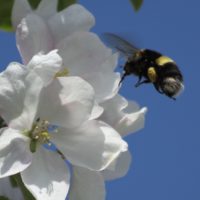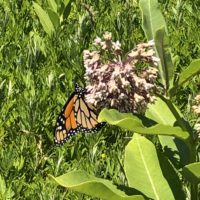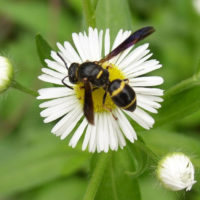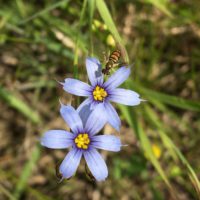Take Flight with Grassland Pollinators
How many pollinators can you name? Honeybees are the world’s most famous pollinators, but they’re not the only ones. Pollinators include insects, birds, bats, and even some reptiles. Some pollinators are generalists, meaning they will pollinate all plants, while others only pollinate specific species. Pollination syndromes are the characteristics of the plant flower that attract different pollinators. These characteristics are color, flower shape, odor, nectar, nectar guides, and pollen.
Let’s take a look at 5 examples of native pollinators and the relationships they have with pollen and the overall ecosystem.
Bees

Bumblebee & Apple Tree
Bees are the universal mascot for pollination. In North America, there are over 4,000 species of native bees. Bees are often attracted to symmetrical, tubular flowers and use their ability to see ultraviolet light to detect if a flower has available nectar. Many bee-favored plants offer pollen freely on their anthers, just needing slight contact; the pollen is usually sticky, which facilitates a high rate of pollination in combination with a bee’s fuzzy abdomen. About 8% of plants are conservative with their pollen and require buzz pollination. This is when a bee rapidly contracts its muscles in a flower, reaching just the right frequency which results in the plants expelling about 20% of their pollen.
This Vibrating Bumblebee Unlocks a Flower’s Hidden Treasure
Butterflies
 Beautiful butterflies are the focus of many pollinator gardens. Plants evolved for butterfly pollination typically produce large clusters of flat, bright flowers and offer more nectar than pollen. These characteristics make it easy for butterflies to land. Butterflies collect nectar through their proboscis, a straw-like part of their mouth. While extracting nectar, they collect pollen on their body, which they then bring to other flowers. An example of a specialized pollinator-plant relationship is between the Monarch Butterfly and milkweed. Milkweed is the only place where Monarchs can lay and support their eggs. Planting milkweed is a great way to help Monarch Butterfly populations.
Beautiful butterflies are the focus of many pollinator gardens. Plants evolved for butterfly pollination typically produce large clusters of flat, bright flowers and offer more nectar than pollen. These characteristics make it easy for butterflies to land. Butterflies collect nectar through their proboscis, a straw-like part of their mouth. While extracting nectar, they collect pollen on their body, which they then bring to other flowers. An example of a specialized pollinator-plant relationship is between the Monarch Butterfly and milkweed. Milkweed is the only place where Monarchs can lay and support their eggs. Planting milkweed is a great way to help Monarch Butterfly populations.
Butterfly Behavior & Plant Evolution
Wasps

Wasp & Aster
Most wasps are general pollinators who accidentally transfer pollen as they hunt for nectar and insects. Unlike bees, most wasps are smooth, so less pollen sticks to their bodies. While most in the wasp genus are predators who feed insects to their young, the pollen wasp is the exception. Like butterflies, they prefer nectar for nourishment and serve a similar ecological role. Common wasps in North America are the paper and potter wasps.
What do Wasps Pollinate?
Flies

Fly & Wildflower
Flies are among the most common visitors to flowers. Flies vary greatly in their effectiveness as pollinators; some have developed specific relationships with plants while others are generalists who accidentally pollinate. Overall, flies rank just below bees in regards to global pollination, especially in tropical crops. In addition to direct pollination, many flies aid in decomposing organic matter which improves soil health. Even the common (and, some think, annoying) housefly is a mango and avocado pollinator.
Fantastic Fly Pollinators
Wind

Freshkills Grassland
Native grasses and popular grain crops typically don’t rely on pollinators. Instead, they produce ample pollen grain to be spread by the wind. Anemophily is the process of wind-based pollination. Wind pollinated plants typically don’t flower, or produce small, unscented, and unnoticeable flowers, because they did not evolve to attract pollinators. However, native grasses assist pollinators by providing food, shelter, and protection from predators.
Grasses and Wind Pollination
Connect with Freshkills
 Planting a diverse selection of native plant species is the key to a balanced ecosystem. Use your knowledge of pollination syndromes to influence the pollinators that visit. For example, if you want more butterflies and less bees, plant red flowers, which bees can’t see and are more likely to ignore. A healthy garden includes plants and pollinators.
Planting a diverse selection of native plant species is the key to a balanced ecosystem. Use your knowledge of pollination syndromes to influence the pollinators that visit. For example, if you want more butterflies and less bees, plant red flowers, which bees can’t see and are more likely to ignore. A healthy garden includes plants and pollinators.
Did any of these pollinators surprise you or spark an interest in further exploration?
Share your thoughts, reactions or questions on pollinators online using @FreshkillsUpStream




